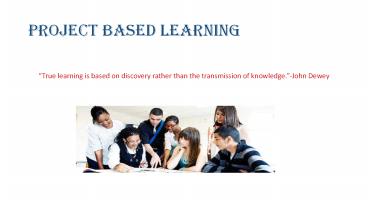Project based learning right from schooling - PowerPoint PPT Presentation
Title:
Project based learning right from schooling
Description:
A mandated shift in the teaching/learning process – PowerPoint PPT presentation
Number of Views:337
Title: Project based learning right from schooling
1
Project Based Learning
- True learning is based on discovery rather than
the transmission of knowledge.-John Dewey
2
Imagine this.
- You look for the teacher as you enter his
classroom. - She isnt located at the front end
- Slowly you trace her among a group of students
- You further notice students in several groups
working seriously - You are curious to check what they are doing
- But you dont dare breaking their concentration
- The teacher notices you and starts towards you
- As she passes every group stops her to proudly
show off their work - You talk for 8 minutes and notice are still
engrossed, animated and focused
3
Project-based learning is going on. in her
classroom
- Its a dynamic approach to teaching
- Students explore real-world problems and
challenges - Makes school more like real life
4
History of PBL
- 1960s-recorded
- 1970s- McMaster University medical school
- 1985-Llinois Math Science Academy
- 1990s- Medical schools across North America
Europe - 200s and beyond- Elementary schools, middle
schools, high schools, universities and
professional schools
5
PBL-Advantages
- Resembles real life problems
- Well structured
- Engages students better
- Relevant and meaningful to the learner
- Enables learners articulate their feelings
- Increases critical thinking, collaboration,
communication, reasoning, synthesis, and
resilience among students - Builds people skills and improves the overall
attitude of the learners
6
PBL- Planning
- Start with the end in mind
- Select a problem/task
- Select the content/method/design assessment
- Set the stage (Lead-in and elicit)
- Set the guidelines
- Anchor the activity (Eg Human trafficking)
- Guide the task (Resources and links)
- Let the students investigate -search
library/browse web/seek experts ideas - Let the students brainstorm/negotiate/collaborate/
resolve conflicts - Let the students create and present artifact
7
Dimensions of PBL
- Core curriculum
- Real-world connection
- Extended time frame
- Student decision making
- Collaboration
- Assessment
- Multimedia
8
Role of a Teacher
- Select authentic tasks
- Structure the lesson and activity
- Model
- Coach
- Scaffold
- Provide feedback
- Facilitate learning
9
Role of Students
- Construct their own knowledge
- Stay self-directed
- Work on the task
- Take the ownership of learning
- Learn on a broader perspective
10
The other side
- Time consuming
- Challenging
- Teacher role isnt conspicuous
- Teacher has to do a lot of background work
- Learners need to shoulder the responsibility of
learning - walking an extra mile
- Teething troubles
11
A good project
- Isnt a one-shot lesson
- Extends over a period of time (days/weeks/months)
- May vary with the age of students
- Students derive pride and a clear sense of
accomplishment - Is a powerful real-world learning experience
12
Some guidelines to develop units based on this
strategy
- Any subject/any grade/Learner-centered themes
- A realistic problem or project
- aligns with students' skills and interests
- requires learning clearly defined content and
skills (e.g. using rubrics, or examples from
local professionals and students) - Structured group work
- groups of three to four students, with diverse
skill levels and interdependent roles - team rewards
- individual accountability, based on student
growth - Multi-faceted assessment
- multiple opportunities for students to receive
feedback and revise their work (e.g., benchmarks,
reflective activities) - multiple learning outcomes (e.g.,
problem-solving, content, collaboration) - presentations that encourage participation and
signal social value (e.g. exhibitions,
portfolios, performances, reports) - Participation in a professional learning network
- collaborating and reflecting upon PBL experiences
in the classroom with colleagues - courses in inquiry-based teaching methods
13
Related URLs to PBL
- A number of online networks support teachers to
develop their expertise in PBL methods. PBL
teachers share project ideas, receive feedback,
and interact with other PBL classrooms using
these links - Buck Institute for Education's (BIE)
Project-Based Learning network on Edmodo - Edutopia's PBL discussion group.
- BIEs free project-based-learning resources
- online professional-development courses in PBL.
14
The Focal point
- We neednt teach language or content to our
students, we have to teach language plus content,
and we should make it meaningful with social
purpose.
15
The Makeover
16
A shift mandated by the global world
17
Bottom line
- PBL fosters life-long learners,
- and..
- life-long learners make good citizens
18
(No Transcript)































